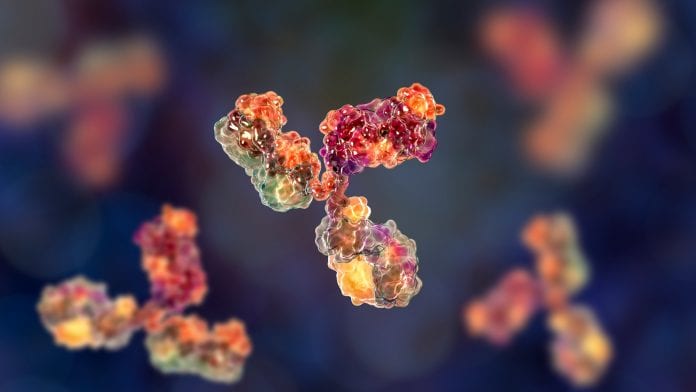
A new technique has been developed by scientists which, in combination with the use of artificial intelligence, could speed up potential new antibody-based drug discovery.
New research from an eight-year collaboration between scientists at the University of Leeds and the biopharmaceutical company AstraZeneca has resulted in a technique that allows fragments of antibodies to be screened for susceptibility to aggregation caused by structure disruption much earlier in the drug discovery process. The scientists hope that the new approach, combined with artificial intelligence and machine learning, will help identify patterns in protein sequences that can inform as to whether a drug can be scaled up for production.
The approach is published in the journal Nature Communications.
Drug discovery
Antibody therapies can be highly effective in treating disease, but challenges can arise when promising candidate antibodies are produced at a large scale. Stresses encountered during manufacturing can disrupt the structure of these fragile proteins leading to aggregation and loss of activity. This in turn prevents them from being made into a therapeutic.
Lead researcher, Dr David Brockwell, Associate Professor in the Astbury Centre for Structural Molecular Biology at the University of Leeds, said: “Antibody therapeutics have revolutionised medicine. They can be designed to bind to almost any target and are highly specific.
“But a significant problem has been the failure rate of candidates upon manufacturing at industrial scale. This often only emerges at a very late stage in the development process – these drugs are failing at the last hurdle. But our research is turning that problem on its head.”
The researchers have a range of proteins to screen to determine which are more likely to progress through the development process.
Professor Sheena Radford, FRS, Director of the Astbury Centre for Structural Molecular Biology, said: “The collaboration that has existed between the team of scientists within the University of Leeds and AstraZeneca demonstrates the power of industry and academia working together to tackle what has been one of the major roadblocks preventing the efficient and rapid development of these powerful therapeutic molecules.”
Screening the target proteins
The scientists clone the target proteins into the centre of an enzyme which then breaks down antibiotics in the bacterium E. coli. This enables the scientists to directly link antibiotic resistance of the bacteria to how aggregation-prone the antibody fragment is.
A simple readout from the bacterial growth on an agar plate containing antibiotic then gives an indication of whether the target protein will survive the manufacturing process. If the antibody proteins are susceptible to stress, they will unfold or clump together, become inactive, and the antibiotic will kill the bacteria. However, if the protein chain is more stable, the bacteria thrives and will display antimicrobial resistance and will grow in the presence of the antibiotic.
The scientists harvest the bacteria that have survived and identify the cloned protein sequence. That indicates which protein sequences to take forward in the development pipeline.
Directing evolution
The scientists make nature do the work by using the idea of natural selection, where mutations or changes take place in the proteins, sometimes making them more stable. The method involves applying evolutionary pressure through natural selection with the use of antibiotics – selecting for the survival of bacteria that produce the protein variants that do not aggregate.
The resisting proteins are then sequenced and scored to select the best ones, followed by a test to see if they retain binding capacity for the original target.
Professor Radford said: “There is tremendous excitement about this approach. We are letting evolutionary selection change the sequence of the proteins for us and that might make some of them more useful as drug therapies. Importantly for industry, nature does the hard work, obviating the need for so called rational engineering which is time, and resource, intensive.
“As we do this, we will be putting the sequence information we gather into a database. As the database gets bigger, it may well be possible with artificial intelligence and machine learning to be able to identify the patterns in protein sequences that tell us that a protein can be scaled up for pharmaceutical production without needing any experiments. That is our next challenge and one we are tackling right now.”
Dr David Lowe, who led the work at AstraZeneca, said: “The screening system that we have developed here is a great example of industry and academia working together to solve important challenges in the development of potential new medicines.
“By combining AstraZeneca’s antibody discovery and screening expertise, together with the Astbury Centre’s world-leading knowledge of protein structure and aggregation, we have produced a high throughput method for rapidly evolving proteins with better biophysical properties that has the potential for wide scientific applicability.”
The research was funded by AstraZeneca, Innovate UK the Biotechnology and Biological Sciences Research Council and the Wellcome Trust.









